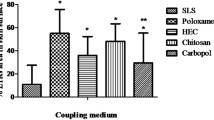Abstract
We have shown previously that high-frequency ultrasound (sonophoresis) can significantly enhance the transdermal delivery of a topically applied drug in vivo and that the augmentation of transport was caused by the action of the ultrasound on the skin. However, these earlier experiments did not reveal (i) the mechanism of sonophoresis, (ii) the pathway of drug permeation under the influence of ultrasound, and (iii) any potentially detrimental effects of the enhancement procedure on skin structure and morphology. In the study reported here, these three key issues have been addressed using electron microscopy to follow the penetration of an electron-dense, colloidal tracer (lanthanum hydroxide; LH). Experiments have again been performed using the hairless guinea pig animal model. Colloidal LH suspensions were applied to skin sites, which were then immediately exposed to ultrasound (at 10 or 16 MHz) for 5 or 20 min. Passive transport of LH under identical conditions (but without ultrasound) provided the control measurements. Tissue processing after the treatment periods utilized standard electron microscopy staining procedures. We found the following: (1) LH does not permeate the skin by passive diffusion; under the influence of ultrasound, on the other hand, it penetrates through the stratum corneum (SC) and the underlying viable epidermal cell layers via an apparently intercellular route. (2) LH transports through the epidermis to the upper dermis, even after only 5 min of ultrasound treatment, a remarkable and unexpected finding. (3) The SC and the cells of the epidermis do not appear to be adversely affected by either (a) ultrasound treatment at 10-MHz frequency (5- or 20-min exposure) or (b) 5 min of sonophoresis at 16 MHz. However, a 20-min treatment with ultrasound at 16 MHz resulted in altered cellular morphology compared to the passive control. The distribution of the tracer in the latter experiments was nonuniform and suggested that cavitational effects may have contributed to the adverse observations. Overall, the results demonstrate that exposure of the skin to ultrasound can induce the considerable and rapid facilitation of LH transport via an intercellular route. Prolonged exposures at high frequencies, however, can alter epidermal morphology, leading us to pose further questions pertaining to the duration and reversibility of ultrasound action on skin.
Similar content being viewed by others
REFERENCES
D. Bommannan, H. Okuyama, P. Stauffer, and R. H. Guy. Sonophoresis. I. The use of ultrasound to enhance transdermal drug delivery. Pharm, Res. 9:559–564 (1992).
D. Bommannan. Ph.D. thesis, University of California, San Francisco.
R. O. Potts and M. L. Francoeur. Lipid biophysics of water loss through the skin. Proc. Natl. Acad. Sci. 87:3871–3873 (1990).
K. Knutson, R. O. Potts, D. B. Guzek, G. M. Golden, J. E. McKie, W. J. Lambert, and W. I. Higuchi. Macro-and molecular physical-chemical considerations in understanding drug transport in the stratum corneum. J. Control. Release 2:67–87 (1986).
A. R. Williams. Ultrasound: Biological Effects and Potential Hazards, Academic Press, San Francisco, 1983.
M. W. Miller, G. E. Kaufman, F. L. Cataldo, and E. L. Cartensen. Absence of mitotic reduction in regenerating rat livers exposed to ultrasound. J. Clin. Ultrasound 4:169–172 (1976).
D. L. Miller, W. L. Nyborg, and C. C. Whitcomb. Platelet aggregation induced by ultrasound under specialized conditions in vitro. Science 205:505–507 (1979).
American Institute of Ultrasound in Medicine. Bioeffects report. J. Ultrasound Med. 7:S1–S38 (1988).
P. M. Elias and B. E. Brown. The mammalian cutaneous permeability barrier. Lab. Invest. 39:574–583 (1987).
C. Cullander, G. K. Menon, R. H. Guy, and P. M. Elias. In situ visualization of the lamellar body secretory system by confocal microscopy. J. Invest. Dermatol. 94:517 (1990).
H. Schaefer, G. Stuttgen, A. Zesch, W. Schalla, and J. Gazith. Quantitative determination of percutaneous absorption of radiolabeled drugs in vitro and in vivo by human skin. Curr. Problems Dermatol. 7:80–94 (1978).
H. E. Boddé, M. A. Kruithof, J. Brussee, and H. K. Koerten. Visualization of normal and enhanced HgCl2 transport through human skin in vitro. Int. J. Pharm. 53:13–24 (1989).
M. K. Nemanic and P. M. Elias. In situ precipitation: A novel cytochemical technique for visualization of permeability pathways in mammalian stratum corneum. J. Histochem. Cytochem. 28:573–578 (1980).
J. P. Revel and M. J. Karnovsky. Hexagonal array of subunits in intercellular junctions of the mouse heart and liver. J. Cell Biol. 33:C7–C12 (1967).
M. A. Hayat. Positive Staining for Electron Microscopy, Van Nostrand Reinhold, New York, 1975, pp. 163–186.
I. S. Harper, K. Williams, and A. Lochner. Lanthanum probing of cell membrane permeability in the rat heart: Pathological versus artefactual alterations. J. Electron Microsc. Tech. 14:357–366 (1990).
S. E. Hou, A. K. Mitra, S. H. White, G. K. Menon, R. Ghadially, and P. M. Elias. Membrane structures in normal and essential fatty acid-deficient stratum corneum: Characterization by ruthenium tetroxide staining and X-ray diffraction. J. Invest. Dermatol. 96:215–223 (1991).
Author information
Authors and Affiliations
Rights and permissions
About this article
Cite this article
Bommannan, D., Menon, G.K., Okuyama, H. et al. Sonophoresis. II. Examination of the Mechanism(s) of Ultrasound-Enhanced Transdermal Drug Delivery. Pharm Res 9, 1043–1047 (1992). https://doi.org/10.1023/A:1015806528336
Issue Date:
DOI: https://doi.org/10.1023/A:1015806528336



